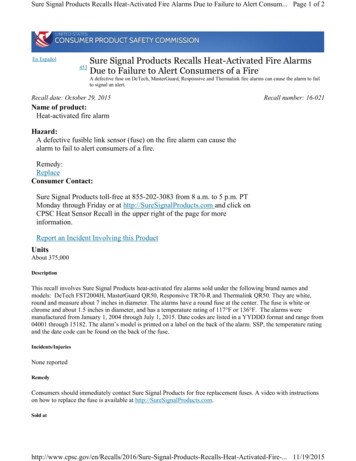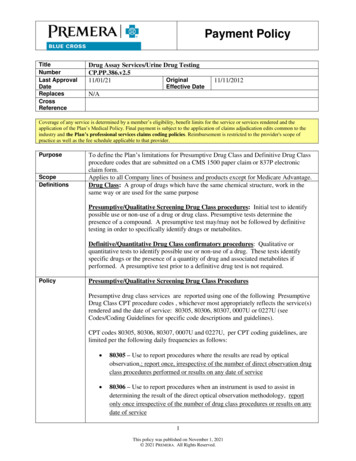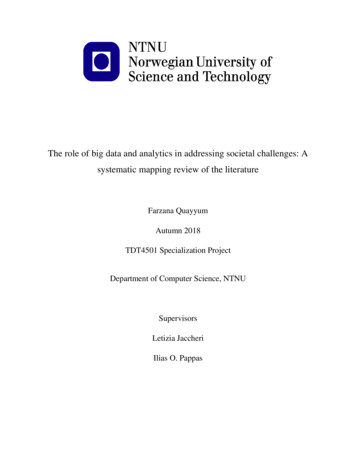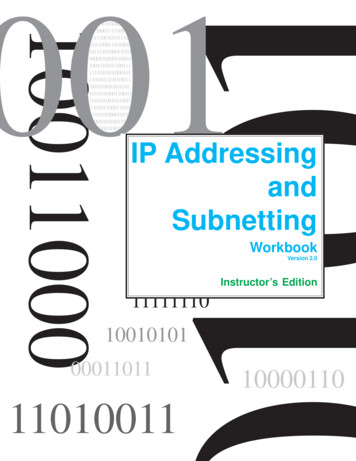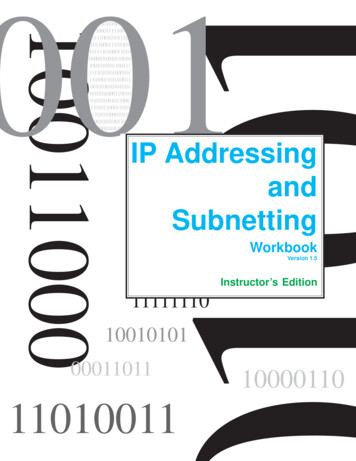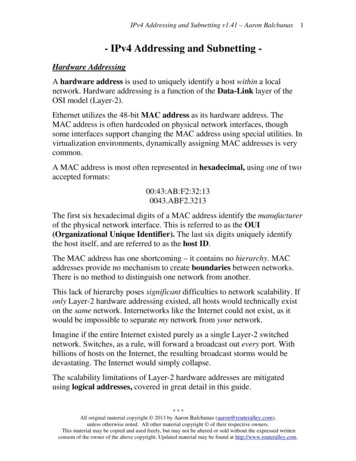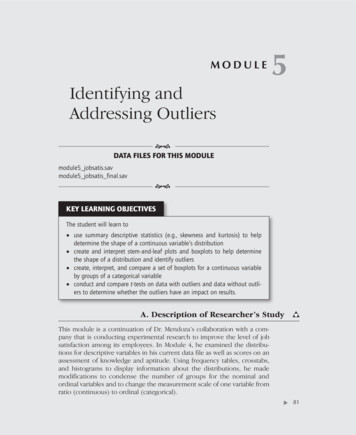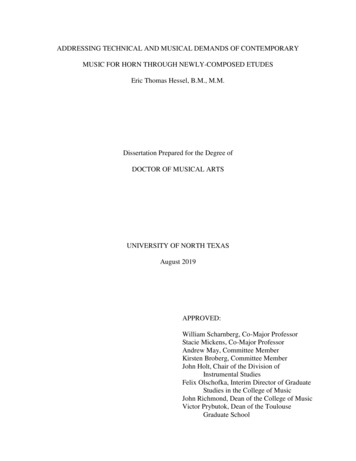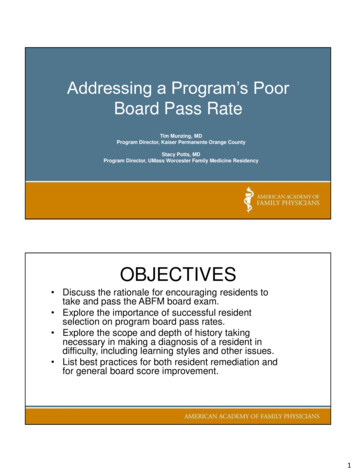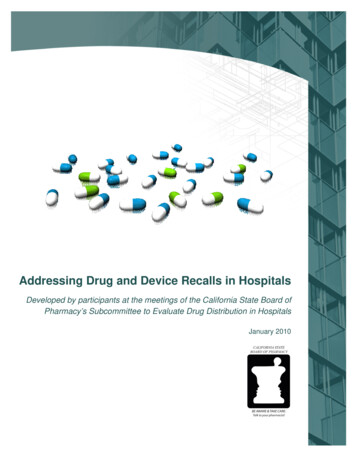
Transcription
Addressing Drug and Device Recalls in HospitalsDeveloped by participants at the meetings of the California State Board ofPharmacy’s Subcommittee to Evaluate Drug Distribution in HospitalsJanuary 2010
January 2010BOARD MEMBERSKenneth H. Schell, Pharm.D.PresidentRandy B. Kajioka, Pharm.D.Vice PresidentStanley C. Weisser, R.Ph.TreasurerRyan L. Brooks, Public MemberRamón Castellblanch, Public MemberRosalyn Hackworth, Public MemberGregory N. Lippe, Public MemberRobert E. Swart, Pharm.D.Deborah Veale, R.Ph.Shirley Wheat, Public MemberTappan Zee, Esq., Public MemberVirginia HeroldExecutive OfficerJanuary 20101625 N. Market Blvd., Suite N-219, Sacramento, CA 95834ph 916.574.7900 fx 916.574.8618 www.pharmacy.ca.gov
January 2010Note:This is a guidancedocument (not law, statuteor regulation) for recalls inhospitals, and represents alist of possible actions totake to remove recalleddrugs from all patient careareas in hospitals.These practices can be summarized as:1. Pre-position the facility to receivemultiple sources,notice of recalls from2. Identify if the facility has the product,3. If so, quickly remove the product from all patient care areas,4. Identify, assess, notify and treat patients who may havereceived the product,5. Identify alternative products to maintain therapy,6. Return the quarantined product,7. Document and evaluate the process.
January 2010Actions for RecallsA product recall includes any notice from a drug manufacturer, wholesaler and/or FDA to return a drug productor medical device due to suspected contamination or defect. For ease of discussion throughout thisdiscussion, “drug product” also includes medical device.Pre-Recall PlanningThe pharmacy department has direct authority and ultimate responsibility for implementation of the facility’srecall policy and procedures. To achieve this, the hospital’s administration needs to provide full support to thepharmacy department in executing the duties described below.The pharmacy department should develop and implement written policies and procedures for the effective andefficient removal of recalled products from all patient care areas (inpatient and outpatient) and storage areas.However, policy and procedure development must be multidisciplinary in approach. At a minimum,representatives from nursing, medicine, pharmacy services and administration should be involved. The focusshould encompass all patient care areas, including outpatient services.1. Components of Written Procedures for Recalls: Develop a duties or detail list with all steps needed to be taken during a recall so that any staff membercan effectively carry out the steps. The procedures should identify the specific roles andresponsibilities of all personnel involved in the recall process in sufficient detail to ensure maximumcompliance. For many hospitals, a dedicated and trained recall team that knows all the policies,procedures and pertinent regulations will provide best support to the hospital in responding consistentlyin handling recalls. In other hospitals, fewer staff may be involved. Ensure knowledge of drug recall procedures by developing facility-wide systems and providing periodictraining at least annually. Ensure that:oStaff understand federal and state regulations governing drug product or medical device recalls.oCommunication occurs about all pertinent recall information and a notice of the recall isdistributed to all impacted areas and appropriate staff in a timely manner.oVarious communication avenues throughout the organization are used to spread notices ofrecalls (email, fax inter-campus, interoffice mail, hospital newsletter – some of these methodsare too slow but can serve as reminders).oFlyers are posted about recalls; for example, post flyers saying “bad heparin” with the lotnumbers recalled.oThere is a centrally located repository of recall notices that is readily retrievable.2. Know All Drug Storage Areas in Hospitals: Maintain control over drug storage everywhere in the hospital. Identify all locations where drugs arekept throughout the hospital: prohibit storage outside these areas.
January 2010 Allow no drugs in the hospital that were not purchased through the pharmacy. There should be noallowance for drugs to be brought in for patient use without the express knowledge and approval of thepharmacy department.Medical devices should be inventoried and controlled in a manner that facilitates their rapid location bymodel product or serial number.the manufacturer, Minimize the number of and maximize the quality and authority of the individuals carrying out monthlyinspections. Ensure that someone is authorized to do what is necessary to secure the drug supplythroughout the facility. During monthly inspections, check for recently recalled drugs to double checkthey have been removed from the hospital’s supplies.3. Once a Recall Has Been Initiated: Establish a centralized method to receive, interpret and disseminate information about recalls,especially Class 1 recalls. Assess the actual or potential clinical significance of the recall on patient care, and identify alternativedrug therapy for recalled drugs or devices. Specify who is responsible for checking specified drug storage areas and obtain a signoff by theindividual conducting the check. Establish timelines for completion of each task. Establish a method to ensure all drug storage areas are checked, and then perform an audit. Forexample, after recall notices are faxed to all pharmacies, require all responses confirming that allrecalled drugs have been removed be returned within 72 hours. After the faxes are received, considerdouble checking via audit of the drug storage locations. Ensure that recalled drugs and devices are stored by the pharmacy in an area clearly designated as aquarantine area until disposed of as directed in the recall notice.4. Additional Steps: Monitor subsequent product shipments to ensure recalled products are not shipped into the facility. Establish a system by which patients who may have been affected by the recalled product areidentified and the patients’ primary physician is notified and provided with recall information. Establish a system to monitor implementation on a regular basis to provide insight into opportunities forprocess improvement.5. Quality Assurance and Process Improvement: Implement monthly reporting of recall activities. Such reports should include:oThe number of recalls received by the organization.oThe number of recalls requiring action by the organization.oThe length of time from receipt of the recall notice until closure is attained.oThe number of patients affected or potentially affected, including any adverse outcomes.oThe location and quantity of recalled product returned.
January 2010o Identification of any problems encountered with the recall process.Share these reports with staff to review and identify opportunities for process improvement.6. Activities with Drug Wholesalers to Improve Recalls: Have a wholesaler representative dedicated to the hospital or hospital group. Alternatively, designateone person as the hospital’s liaison with the wholesaler. This person can run reports and identifyrecalled drugs purchased by the hospital. Collaborate and communicate with the wholesaler on drug shipments and recalls, including shipmentsafter a recall is announced.7. Technology-Based Solutions: Stock drugs in automated dispensing cabinets (Pyxis, Omnicell) to easily and quickly do an electroniclockout for recalls. Implement an adverse drug reaction system that allows better tracking of what occurred in relation to arecalled drug was administered to patients. Outcome: better communication with patients. Obtain an electronic receipt of recall notices from multiple sources.IMPROVEMENTS FOR THE RECALL SYSTEM:1. Notification System for Recalls Needs Improvement: Have a more effective recall notification system that originates in one place, listing what the issue is,what should be done, what steps should be taken, etc. Having one notice from one source with all therelevant information would minimize confusion. Encourage the FDA to develop a standardized format for recalls, including listing the reason for therecall, so adherence is easier to achieve. Recall notices should state whether the recall is a Class I, II or III recall. Also, notices should haveclear instructions about what actions to take. Encourage wholesalers to communicate recalled lot numbers to purchasers of their products. Recalled products repackaged under another name or brand by a different distributor should berecalled by all names, and a separate recall notice should be listed for the distributor.2. Establish Tracking of Drugs Throughout the Hospital: Institute bar coding to better track drugs throughout the facility. Hospitals need to prioritize bar codingtechnology. Electronic tracing or notification (e.g., secure email) of recalls would be helpful. Institute RFID or bar codes and advocate to have standardized methodology in the way the informationis sequenced. This should apply to the entire lifecycle of the product, so a recalled product can beidentified in the hospital. E-pedigree requirements would enable better execution of a recall within ahospital.
January 20103.Methods of Obtaining Recall Information: Redundant notification systems should be established to ensure the facility receives recall notices.Facilities are encouraged to subscribe to more than one method available for product recalls. Solereliance on recall notification via the US Postal Service is not acceptable. Recall notices can arrive at hospitals via fax, certified letter, standard mail, emails from manufacturers,wholesalers, or notices with invoices for other drugs. Listserves of the , the California Board of Pharmacy and other entitiescan provide recall information. Closely working with the hospital’s drug wholesalers will improve notice and distribution of recallinformation.4. Administrative Policies Require that drugs be stored in specific locations and institute consequences when drugs are storedout of these areas. Increase the authority of the pharmacist-in-charge to better control where and howdrugs are stored. Expand policies to increase responsibility of other department heads during a recall. All health careproviders that are touching the drug are accountable. Bring together management, California Hospital Association, Medical Board, Nursing Board and Boardof Pharmacy. Other health care providers should be cited and fined for their failure to follow thefacility’s recall procedures.5. “Geographic” Concerns: Ensure there is a system to identify all outpatient clinics and other departments that are on the facility’slicense. This will help clarify what a pharmacist-in-charge is responsible for. Establish guidelines for an authorized medication storage area. Outside medications from vendors or contractors should not be allowed in the hospital.
Recall notices should state whether the recall is a Class I, II or III recall. Also, notices should have clear instru ctions about what actions to take. . Bring together management, California Hos

